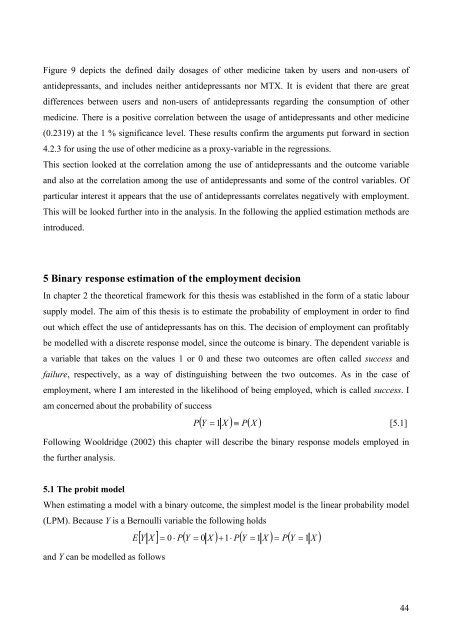An Analysis on Danish Micro Data - School of Economics and ...
An Analysis on Danish Micro Data - School of Economics and ...
An Analysis on Danish Micro Data - School of Economics and ...
You also want an ePaper? Increase the reach of your titles
YUMPU automatically turns print PDFs into web optimized ePapers that Google loves.
Figure 9 depicts the defined daily dosages <strong>of</strong> other medicine taken by users <strong>and</strong> n<strong>on</strong>-users <strong>of</strong><br />
antidepressants, <strong>and</strong> includes neither antidepressants nor MTX. It is evident that there are great<br />
differences between users <strong>and</strong> n<strong>on</strong>-users <strong>of</strong> antidepressants regarding the c<strong>on</strong>sumpti<strong>on</strong> <strong>of</strong> other<br />
medicine. There is a positive correlati<strong>on</strong> between the usage <strong>of</strong> antidepressants <strong>and</strong> other medicine<br />
(0.2319) at the 1 % significance level. These results c<strong>on</strong>firm the arguments put forward in secti<strong>on</strong><br />
4.2.3 for using the use <strong>of</strong> other medicine as a proxy-variable in the regressi<strong>on</strong>s.<br />
This secti<strong>on</strong> looked at the correlati<strong>on</strong> am<strong>on</strong>g the use <strong>of</strong> antidepressants <strong>and</strong> the outcome variable<br />
<strong>and</strong> also at the correlati<strong>on</strong> am<strong>on</strong>g the use <strong>of</strong> antidepressants <strong>and</strong> some <strong>of</strong> the c<strong>on</strong>trol variables. Of<br />
particular interest it appears that the use <strong>of</strong> antidepressants correlates negatively with employment.<br />
This will be looked further into in the analysis. In the following the applied estimati<strong>on</strong> methods are<br />
introduced.<br />
5 Binary resp<strong>on</strong>se estimati<strong>on</strong> <strong>of</strong> the employment decisi<strong>on</strong><br />
In chapter 2 the theoretical framework for this thesis was established in the form <strong>of</strong> a static labour<br />
supply model. The aim <strong>of</strong> this thesis is to estimate the probability <strong>of</strong> employment in order to find<br />
out which effect the use <strong>of</strong> antidepressants has <strong>on</strong> this. The decisi<strong>on</strong> <strong>of</strong> employment can pr<strong>of</strong>itably<br />
be modelled with a discrete resp<strong>on</strong>se model, since the outcome is binary. The dependent variable is<br />
a variable that takes <strong>on</strong> the values 1 or 0 <strong>and</strong> these two outcomes are <strong>of</strong>ten called success <strong>and</strong><br />
failure, respectively, as a way <strong>of</strong> distinguishing between the two outcomes. As in the case <strong>of</strong><br />
employment, where I am interested in the likelihood <strong>of</strong> being employed, which is called success. I<br />
am c<strong>on</strong>cerned about the probability <strong>of</strong> success<br />
( Y X ) P(<br />
X )<br />
P = 1 ≡<br />
[5.1]<br />
Following Wooldridge (2002) this chapter will describe the binary resp<strong>on</strong>se models employed in<br />
the further analysis.<br />
5.1 The probit model<br />
When estimating a model with a binary outcome, the simplest model is the linear probability model<br />
(LPM). Because Y is a Bernoulli variable the following holds<br />
<strong>and</strong> Y can be modelled as follows<br />
[ Y X ] = 0 ⋅ P(<br />
Y = 0 X ) + 1⋅<br />
P(<br />
Y = 1 X ) = P(<br />
Y = X )<br />
E 1<br />
44
















